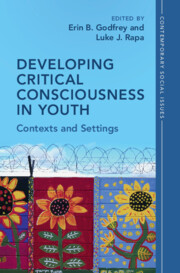Book contents
- Developing Critical Consciousness in Youth
- Contemporary Social Issues Series
- Developing Critical Consciousness in Youth
- Copyright page
- Dedication
- Contents
- Figures
- Tables
- Contributors
- Acknowledgments
- Introduction
- Part I Pedagogical, Curricular, and School-Based Contexts
- 1 Tools of Whiteness and Teaching for Critical Consciousness
- 2 Critical Consciousness Development in the Context of a School-Based Action Civics Intervention
- 3 Critical Consciousness Development in Place-Based Action Civics
- Part II Extracurricular Contexts
- Part III Societal Contexts
- Index
- References
3 - Critical Consciousness Development in Place-Based Action Civics
from Part I - Pedagogical, Curricular, and School-Based Contexts
Published online by Cambridge University Press: 11 May 2023
- Developing Critical Consciousness in Youth
- Contemporary Social Issues Series
- Developing Critical Consciousness in Youth
- Copyright page
- Dedication
- Contents
- Figures
- Tables
- Contributors
- Acknowledgments
- Introduction
- Part I Pedagogical, Curricular, and School-Based Contexts
- 1 Tools of Whiteness and Teaching for Critical Consciousness
- 2 Critical Consciousness Development in the Context of a School-Based Action Civics Intervention
- 3 Critical Consciousness Development in Place-Based Action Civics
- Part II Extracurricular Contexts
- Part III Societal Contexts
- Index
- References
Summary
Design Your Neighborhood (DYN) is a place-based action civics curriculum that teaches urban design as a tool for increasing civic participation among youth. The DYN curriculum consists of six-week cross-curricular units for seventh and eighth grade that address local urban design issues that have exacerbated inequality in a rapidly growing southeastern US city. This chapter presents findings related to critical consciousness collected from an ongoing longitudinal, quasi-experimental, mixed-methods study of DYN. Quantitative data includes two measures of critical consciousness collected from treatment and control groups at two timepoints. Qualitative data comes from focus groups with students who completed the curriculum. Although qualitative findings suggest students’ critical consciousness increased after engaging with DYN, descriptive and inferential analysis of quantitative data indicate variation in student outcomes related to critical consciousness. These findings suggest pathways for place-based action civics to better support students’ development of critical motivation and critical action in and out of the classroom.
- Type
- Chapter
- Information
- Developing Critical Consciousness in YouthContexts and Settings, pp. 60 - 82Publisher: Cambridge University PressPrint publication year: 2023
References
- 2
- Cited by



